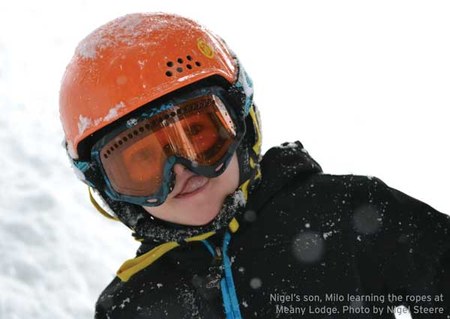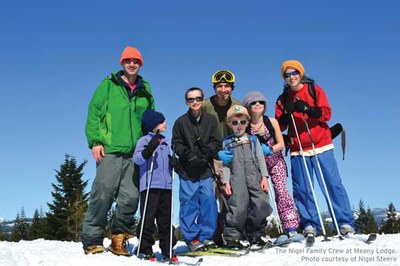
by Kristina Ciari, Membership and Marketing Director
The word ‘adventure’ is used a lot today – overused really. But when you think back on the highlights of your life, surely the memories that stand out are those containing a certain level
of adventure.
For me, one weekend in particular stands out as exceptional. I was in my mid-twenties and had rented a cabin on Lake Wenatchee with ten friends. We were all about the same age and shared the same interests - running and rock climbing. It was Octoberfest weekend, so while a few folks ran in the Leavenworth Half, the rest of us climbed in Icicle Creek, and we all met back at the house for a few evenings of celebration.
Nothing particularly special took place – although we did take turns climbing the rock fireplace to “mantle the mantle” – but what made this particular weekend unique was just how “all-in” everyone was for the entire experience. We arrived together, ate together, danced together, and fell asleep under the same roof together, only to wake up and do it all over again the next day. It was like summer camp – for one short weekend we were all transported to a magical place where we felt safe being silly and inventing fun. The entire thing became one grand adventure.
When the time came for us to go home Sunday morning, we stood together on the back porch and counted down until the exact second when we had to vacate the house. That’s when you know you have a good thing going – no one wants it to end.
Time spent at Meany Lodge is very much the same. The whole endeavor is an all-consuming experience. It’s a place frozen in time where people go to slow down and take in a deep breath.
For this article on the history of Meany Lodge and what it means to spend time there, I sat down with Nigel Steere, a legacy Meanyite and the current Category Manager for Helmets and Goggles at K2 Sports, to talk about his family legacy at Meany, and why he’s so inspired to transport his family there today.
History Of Meany Lodge
Meany Lodge is The Mountaineers oldest winter sports resort, located 60 miles east of Seattle near Stampede Pass. In the winter, Meany is home to 32 downhill runs accessible by a rope tow ascending 450 vertical feet at a blistering 17mph (don’t worry, there’s a slower rope tow for those of us who are “novice tow riders”).
 Completed in 1928, former club Secretary Mrs. Stuart P. Walsh wrote of the ski lodge dedication in the Mountaineer Annual in this way: ”Eight years ago the building of a shelter cabin for ski enthusiasts was unthinkable. So unknown was the sport in the Northwest that the few men and women indulging in it were regarded as veritable superhumans by their sure but clumsy-footed brethren.”
Completed in 1928, former club Secretary Mrs. Stuart P. Walsh wrote of the ski lodge dedication in the Mountaineer Annual in this way: ”Eight years ago the building of a shelter cabin for ski enthusiasts was unthinkable. So unknown was the sport in the Northwest that the few men and women indulging in it were regarded as veritable superhumans by their sure but clumsy-footed brethren.”
Among those early “superhumans” were Bruce and Dawn Steere, Nigel’s paternal grandparents. While they did not build the original structure, they were an early presence in the lodge, and participated in many work parties for the lodge’s add-ons in the late 30’s. Photos of Bruce & Dawn can still be found in the lodge today.
Sadly, Bruce passed away when Nigel’s father was only 9 years old. While Nigel never got to meet his grandfather, he heard stories about The Mountaineers and Meany Lodge from his own father Monte, and uncle Tex, who grew up skiing primarily at The Mountaineers’ Snoqualmie Lodge. Apparently Tex and Monte were quite the pair. They were among the very first skiers to do backflips on skis, forever cementing The Mountaineers’ important role in the evolution of skiing.
Nigel himself learned to ride at Sahale Lodge and only visited Meany once growing up, but the stories of Meany’s rope tow were legendary and he remembers his father talking about it often. “To anyone the rope tow makes a pretty big impression,” Nigel said, of his first visit to Meany. “It’s fast. It’s steep. It’s just a kick.”
A Family Getaway
Life took Nigel away from the Pacific Northwest for a while, but he always intended to return and carry on the tradition started by his grandparents. Together with his wife Sarah, Nigel briefly lived in Colorado and Jackson Hole before moving back to Seattle to work for K2. Six-months after his daughter Hudson was born, Nigel declared that the family was going to Meany for his 31st birthday. They’ve been hooked ever since.
 They welcomed son Milo in 2008, and now their family of four travels to Meany many winter weekends. Nigel loves everything about the entire experience – especially the opportunity for family time. “When you’re on the hill – it’s a very small hill – you’re all skiing together if you want to or not,” he says. “You’re not dropping your kids off at a ski bus or at the hill with their instructor. You’re there together. You’re eating, cleaning, sleeping, doing everything together, and that’s pretty unique. “
They welcomed son Milo in 2008, and now their family of four travels to Meany many winter weekends. Nigel loves everything about the entire experience – especially the opportunity for family time. “When you’re on the hill – it’s a very small hill – you’re all skiing together if you want to or not,” he says. “You’re not dropping your kids off at a ski bus or at the hill with their instructor. You’re there together. You’re eating, cleaning, sleeping, doing everything together, and that’s pretty unique. “
A lot of work goes into running and maintaining the lodge, and Nigel is really blown away by the commitment the Meany regulars put into making it happen. While Meany Lodge has weekend hosts and provides food, everyone pitches in. “The cleaning, sweeping, setup for meals, washing dishes – it’s all good character building,” he says. “The kids take pride in it. They know the rope tow won’t open until everything is clean and the older kids lead by example. It takes them out of their normal element and gives them a strong sense of ownership.”
The appeal of a weekend at Meany goes beyond character building – tangible benefits exist as well. With a family, waiting in line to get on a lift, finding seats in a crowded cafeteria, and all of those inconveniences associated with bigger ski resorts are left behind once you park your car and climb on the 1950’s vintage snow-cat to kick off your voyage to Meany. With Meany, you know you’re going away for a full weekend and all you need to bring is ski gear and a sleeping bag. Leave the coolers of food and worries at home.
“When people come up there for the first time it’s usually a bit of an eye opener,” Nigel says. “It’s off the grid. Your only access to the lodge is skiing-in yourself or being towed in on the Snow-Cat.” While this may sound like a bit of a constraint, it’s quite the contrary. Throughout our conversation Nigel frequently mentioned the freedom offered at Meany. “Whatever you want to do in the snow – you can do. There’s a lot of ability to just be creative. Whether it’s snowshoeing or hiking or touring or skiing the rope tow or building a snow cave. You can do it all and you have time for it.”
A Gateway To Adventure
A few times Nigel quoted the lodge as being A Gateway to Adventure. “It’s a starting point for whatever you want to do. It’s a healthy environment for families where you’re all in it together. There aren’t too many places where your kids can go skiing and you can snowshoe up the hill more or less alongside them,” he says.
The lodge attracts a diverse group, from families with young kids, to college kids who recognize the novelty of the lodge and rope tow experience, to long-time Mountaineers showing everyone the way.
Nigel considers himself lucky that both of his kids have taken well to the snow and to skiing, and he’s capitalizing on the time they have together now while the kids both love it. Even when the weather is wet and soggy. In fact, he doesn’t much mind the rain. “Even if it’s raining there’s lots of stuff to do. Get your Gor-Tex on, it’s going to be an adventure!”
His favorite part about Meany? Introducing new people to it. “The experiences you have up there are so out of the ordinary – you don’t just get on a chairlift and sit down, the whole process is an adventure. From getting on the Snow-Cat to taking the it out at the end of the weekend, it’s stuff the ordinary ski person has never experienced,” he says.
Last year Nigel invited friends for Carnival Weekend at Meany, and their minds were completely blown. “We did so many things this weekend that we have never even seen or done before,” they said of their visit. Nigel’s response? He simply smiled and said, “Welcome to Meany.”
Now if that isn’t adventure, I don’t know what is.
This article originally appeared in our Nov/Dec 2014 issue of Mountaineer magazine. To view the original article in magazine form and read more stories from our publication, click here.
 Kristina Ciari Tursi
Kristina Ciari Tursi